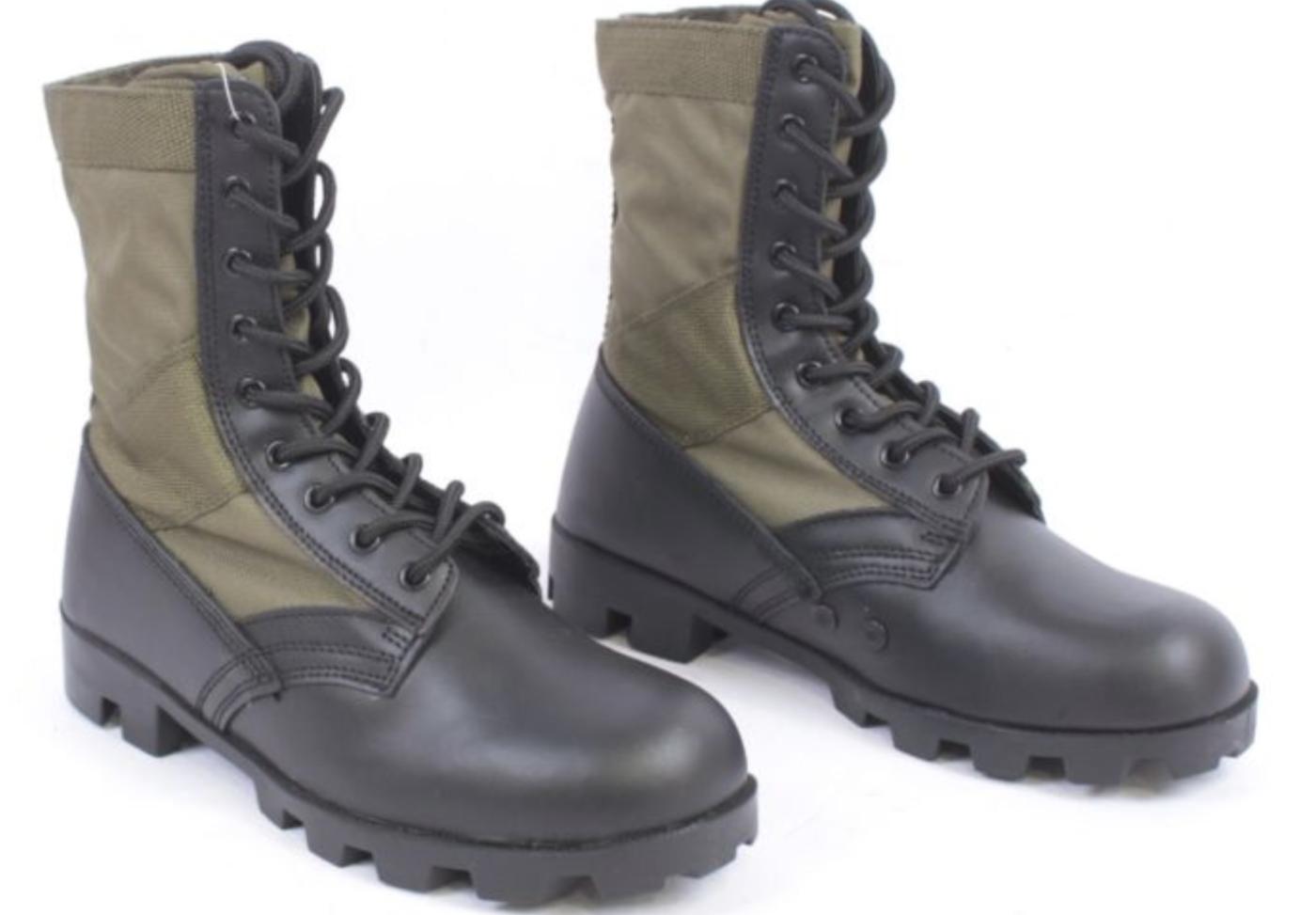
Jungle Boot
The Vietnam Jungle Boot was specifically designed to address the unique and demanding conditions faced by U.S. soldiers during the Vietnam War. The terrain in Vietnam posed significant challenges for soldiers, with its dense jungles, frequent rainstorms, swamps, and humid, tropical climate. Traditional military boots, which were typically made of heavy leather, did not offer the necessary ventilation, water resistance, or traction for the conditions in Vietnam. As a result, the U.S. military began developing a specialised boot designed to meet these environmental demands.
In the early 1960s, the U.S. Army recognised that standard-issue combat boots needed to be adapted for the Southeast Asian theater of operations. A joint effort between military officials and boot manufacturers led to the creation of the Jungle Boot. The boots were designed to offer greater comfort, better drainage, and increased mobility for soldiers moving through the humid, muddy, and often waterlogged jungle. The combination of leather and canvas for the upper part of the boot was chosen for its balance of durability and breathability. The canvas allowed air to circulate, which helped reduce sweating and the growth of foot fungus, a common issue in the hot, humid environment. The leather added structural integrity and protection against abrasions and rough terrain.
One of the most important innovations of the Vietnam Jungle Boot was the drainage system. The boots featured small ventilation holes on the sides, allowing water to drain out of the boots quickly if soldiers waded through streams or rain-soaked areas. This drainage feature was crucial in preventing soldiers from walking around in waterlogged boots, which could lead to blisters, trench foot, and fungal infections. The boots also incorporated a Vibram rubber sole, known for its ability to provide superior traction on slippery and uneven surfaces. The rugged design of the sole helped soldiers maintain stability in muddy, wet, or rocky environments. The sole had a deep tread pattern, providing excellent grip on jungle floors, which were often slick with mud and rain.
The steel shank in the boot's sole was another important feature. This provided additional support and helped soldiers maintain balance while carrying heavy loads across rough terrain. The boot's height was typically about 8 inches, providing some ankle support without limiting flexibility. The boots were designed for mobility, allowing soldiers to move freely, sprint, and adjust to the demands of combat situations in a way that was not possible with bulkier, heavier boots.
Production and Manufacturers
The initial development of the Vietnam Jungle Boot began in 1964, but it wasn't until the mid-1960s that mass production began. The boots were manufactured by several companies under government contracts, with some of the most notable manufacturers being Bates Footwear, Converse, and Belleville Shoe Manufacturing Company.
Bates was a well-known manufacturer of military footwear at the time and played a significant role in producing the Vietnam Jungle Boot. Bates worked closely with the U.S. Army to design and refine the boots to meet the specific needs of soldiers fighting in the Vietnam War. Converse, better known for its iconic Chuck Taylor sneakers, also contributed to the production of the Jungle Boot. Converse’s version of the boot used canvas for the upper portion and rubber for the sole, offering a lighter and more flexible boot for troops in the field. The combination of materials made the boots more breathable and comfortable, especially in the hot and humid conditions. Belleville, another major player in military footwear, produced boots that adhered to the Army’s specifications, ensuring high-quality production standards and large-scale output to meet the wartime demands.
While the precise number of Vietnam Jungle Boots produced is not fully documented, estimates suggest that millions of pairs were made during the conflict. As the war escalated, the demand for specialised footwear grew, and the military ramped up production. The boots were not only issued to U.S. Army and Marine Corps personnel but were also distributed to other branches, including Navy SEALs and Green Berets, as well as foreign military forces and even civilian contractors in Vietnam.
Distribution and Use
By the mid-1960s, the Vietnam Jungle Boot became standard issue for U.S. troops in Southeast Asia. The boots were widely distributed to soldiers stationed in the jungles of Vietnam, as well as to those deployed in other parts of Southeast Asia, such as Laos and Cambodia. Their use was not limited to infantrymen; Special Forces troops, like the Green Berets and U.S. Navy SEALs, found the boots especially useful in their covert operations in the dense, rugged environments. Even journalists and photographers in Vietnam often wore these boots, as they were the go-to footwear for anyone needing durable and functional boots in the harsh jungle conditions.
The boots became synonymous with the U.S. military presence in Vietnam, with their distinctive look: a mix of green canvas, leather, and the large rubber Vibram sole. Over time, the boots became a symbol of the Vietnam War itself, with many soldiers having personal stories about how they relied on them to navigate through the difficult and often dangerous terrain.
End of the War and Legacy
The production of the Vietnam Jungle Boot tapered off after the U.S. military withdrew from Vietnam in 1973. However, the design and technology of the Jungle Boot influenced future generations of military footwear. Modifications and improvements were made in the years following the war to address evolving needs, especially in desert and urban environments, leading to the development of the Desert Combat Boot and other specialised footwear. Nevertheless, the core principles of the Vietnam Jungle Boot—lightweight construction, breathability, drainage, and durability—continued to shape the design of modern combat boots.
The Vietnam Jungle Boot remains one of the most iconic pieces of military gear associated with the Vietnam War. It represented not only the practical needs of soldiers but also the resilience required to survive in one of the most challenging combat environments in history. Even though it is no longer in regular use, the boot's design is still studied and respected as a major achievement in military footwear.










